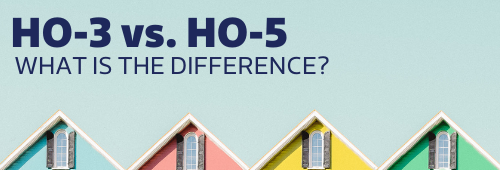HO-3 vs. HO-5 Homeowner's Insurance Policy: What is the Difference?
An important thing to look at when comparing or reviewing your homeowner's insurance is the type of policy it is written as.

Most policies will be written as a HO-3, which can leave you with some coverage gaps you are not aware of. At TROXELL we promote and suggest all insureds purchase a HO-5 policy.
Both the HO-3 and HO-5 cover your house on an open peril basis, but where the HO-5 differs from the HO-3 is how it insures your property inside the home:
| |
HO-3 |
HO-5 |
| Your House |
Open Peril |
Open Peril |
| Your Personal Property |
Named Peril |
Open Peril |
| Personal Property |
Actual Cash Value |
Replacement Cost |
A HO-3 policy only covers your personal property on a Named Peril's basis, whereas a HO-5 plan provides coverage on an Open Peril basis. Also, HO-3 plans typically do not include Replacement Cost Coverage on your personal property. What is considered your personal property inside your home? Items such as clothes, furniture, TVs, toys, rugs, appliances and more.
What does Open Peril and Named Peril mean?
- Named Peril means you only have coverage for perils listed in your policy documents. If your home insurance policy lists fire as a type of covered peril, but not smoke, then smoke coverage would not be included in your Named Peril policy (unless it was caused directly by a fire, which is named).
How can you have smoke damage without a fire? Have you ever left a pizza in the oven to long? Left the Thanksgiving Turkey in for 10 hours instead of 5? While no fire starts, you return to a house filled with smoke. The smoke smell has seeped into your walls, causing permanent damage that needs repair. When you file a smoke claim for a named peril policy that does not list smoke as a covered peril, it would result in a $0 payout.
- Open Peril is a fancy way to say you have coverage for all perils EXCEPT those specifically written as EXCLUDED in your policy. Things like flood, mold and earthquake are things you may find excluded. Therefore, any claim you have will be covered unless it is specifically excluded.
What is the difference between Actual Cash Value and Replacement Cost Coverage for your personal property?
- Actual Cash Value will give you a refund on the depreciated or used value of your item.
- Replacement Cost will reimburse you for the like new or full replacement of the item.
There are optional coverages you can include with your homeowner's policy to give you further protection on your home and personal items such as Water Back-up, Earthquake, special personal property (also known as inland marine), and others.
At TROXELL, we shop out your coverage with over 40 insurance companies but can also include optional coverages to give you the homeowners insurance policy that fits your needs. Ask your TROXELL agent about discounts that you may be eligible for and don't forget to bundle your home and auto for additional savings.
This article was written by:
Ryan Augustine, CIC, CLCS
.jpg) RYAN AUGUSTINE IS AN ACCOUNT EXECUTIVE AT TROXELL. HE WORKS BOTH ON PERSONAL LINES AND COMMERCIAL LINES TO HELP NEW AND EXISTING CLIENTS. RYAN HAS EARNED HIS CERTIFIED INSURANCE COUNSELOR AND COMMERCIAL LINES COVERAGE SPECIALIST DESIGNATIONS.
RYAN AUGUSTINE IS AN ACCOUNT EXECUTIVE AT TROXELL. HE WORKS BOTH ON PERSONAL LINES AND COMMERCIAL LINES TO HELP NEW AND EXISTING CLIENTS. RYAN HAS EARNED HIS CERTIFIED INSURANCE COUNSELOR AND COMMERCIAL LINES COVERAGE SPECIALIST DESIGNATIONS.